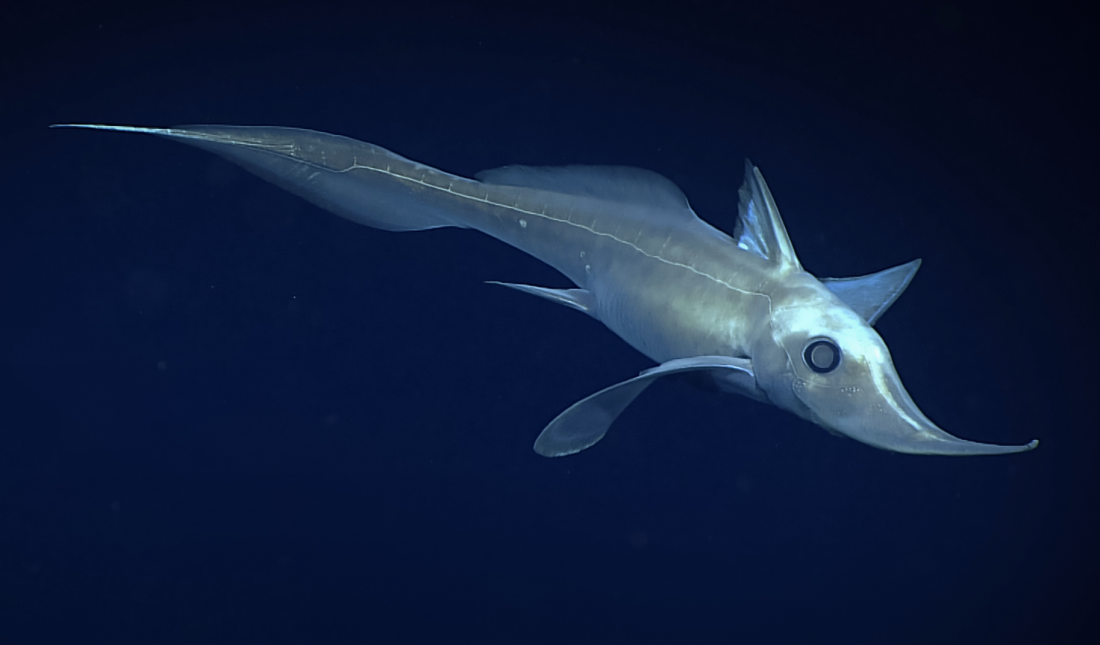Hariotta raleighana, a long-nosed chimaera.
This story is featured in the Asia Research News 2021 magazine. Read in ISSUU (above) or full text and images below.
An international team, including a Hokkaido University researcher, analysed contemporary and future global patterns of temperature change across the oceans’ depths. While a great deal of attention has been paid to how warming waters bleach coral and stress other animals living closer to the surface, this study shows creatures of the deep, where water is colder, are not safe.
“We wanted to challenge the common perception that deep sea biodiversity is less exposed to climate change because deep waters are less variable than surface waters,” says Jorge García Molinos, a climate ecologist at Hokkaido University’s Arctic Research Center, who contributed to the study published in the journal Nature Climate Change. “In fact, we find deep sea biodiversity is likely to be at greater risk because they are adapted to much more stable thermal environments.”
Specifically, García Molinos and his colleagues analysed climate velocity, which describes the speed and physical direction of temperature change, and serves as a proxy for potential shifts of marine biota seeking to maintain their thermal habitats. They found that globally, average climate velocities in the deepest layers of the ocean (deeper than 1,000 metres) have been two to nearly four times faster than at the surface between 1955 and 2005. This is due, in part, to the deep ocean having temperature layers that don’t change much as you move laterally, so animals have to move much longer distances to compensate for even small temperature changes.
The curly-cue shape is a characteristic of this chrysogorgid octocoral, called Iridogorgia.
Notably, even though climate velocities are projected to slow down at the ocean surface if strong action is taken to limit global warming, climate velocities will continue to accelerate in the deep ocean.
“The acceleration of climate velocity for the deep ocean is consistent through all tested greenhouse gas emission scenarios,” García Molinos says. “This provides strong motivation for considering the future impacts of ocean warming on deep ocean biodiversity, which remains worryingly understudied.”
Climate velocities in the mesopelagic layer of the ocean (200-1,000 metres) are projected to be four to 11 times higher than current velocities at the surface by the end of this century. Marine life in the mesopelagic layer includes great abundance of small fish that are food for larger animals, including tuna and squid. This could present additional challenges for commercial fisheries if predators and their prey further down the water column do not follow similar range shifts.
The research team, led by the University of Queensland in Australia, also compared biodiversity levels and climate velocity for more than 20,000 marine species to reveal potential risk areas where high biodiversity and velocity overlap. They found that risk areas for surface and intermediate layers dominate in tropical and subtropical latitudes, but risk areas in the deepest layers are widespread across all latitudes except for the polar regions.
The scientists caution that uncertainty of the results increases with depth. Also, life in the deep ocean is limited by many factors other than temperature, such as pressure, light and oxygen concentrations.
“Without knowing if and how well deep ocean species can adapt to these changes, we recommend following a precautionary approach that limits the negative effects from other human activities, such as deep-sea mining and fishing, as well as planning for climate-smart networks of large marine protected areas that include the deeper ocean,” says García Molinos.
Further Information
Assistant Professor Jorge García Molinos
[email protected]
Arctic Research Center
Hokkaido University





